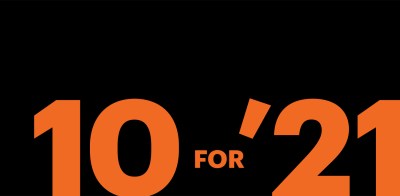Treasury yields have been on the rise for months, but the pace quickened sharply last week, causing ripple effects throughout financial markets. How far will yields go, why now, and what it means for investors are all questions that are more critical now than ever.
Boy, that escalated quickly!
We wrote in our 10 for ’21 that the 10-year Treasury could reach as high as 2% in 2021. At the time, many analysts were much more cautious. After all, at the end of 2020 the 10-year was only at 0.92%. And yet here we are at 1.42% as the pace of rising yields has accelerated. The 10-year rose 8 bps last week and has risen 50 bps since the start of the year. Short-term rates are still anchored at zero, which means that higher yields are impacting long-term rates and the yield curve has steepened sharply. This week saw the 5-year Treasury rise 16 bps to 0.73% and the 30-year return to pre-COVID levels at 2.15%.
10-year Treasury yields are rising fast

Source: Bloomberg Finance, L.P., as of February 25, 2021.
Why now?
The short answer is Fed Chair Powell. But first: Since summer 2020, rates have been slowly but steadily climbing, driven largely by the connection between long-term rates and inflation expectations, which are closely tied to growth expectations. The Fed slashed rates at the beginning of the pandemic and began a fresh round of quantitative easing that included trillions of dollars of Treasury purchases, done expressly to push real interest rates down and steady financial markets. Since then, the economic recovery has been solid, allowing room for interest rates to slowly recover. In November 2020, positive news on vaccines pushed yields up even more. In January, the Georgia runoff elections gave Democrats (slim) control of the Senate, increasing the probability of more generous fiscal stimulus (and therefore higher growth). Through February, new cases of COVID have decreased sharply and the vaccine rollout is gathering steam.
But the final catalyst was Powell’s semiannual policy report to Congress last week. With interest rates already on the rise, concern has been building that the Fed would push back, either through jawboning, expressing rising concerns about inflation, or implementing a more explicit policy to keep rates low (i.e., “Operation Twist”). Powell put these concerns to rest, essentially blessing the trend of rising rates. He was quizzed repeatedly on the implication of rising rates, responding that “it is very important to ask why rates are moving up” and concluding that it seems to be “a statement of confidence” by markets that the economy is on a recovery path. These remarks, plus his observation that we are “a long way from our employment and inflation goals,” imply that Fed policy will remain accommodative for the foreseeable future. This supercharged the trend of higher rates.
It is worth noting that there were some technical factors acting on the fringe of last week’s rate move. The Treasury auction showed some weakened uptake, particularly for the 7-year. That added to volatility on Thursday, pushing the 10-year yield as high as 1.60% before moderating toward the end of the week. Treasuries are considered a highly liquid risk-free instrument. But as the U.S. deficit has soared, the need to roll over large amounts of debt will mean auction sizes that are significantly larger. Certainly, the Fed has the tools to smooth volatility in the Treasury market. But to the extent this dynamic could come into play, it bears close watching in the quarters ahead.
Inflation is the devil they know
Inflation is an important part of the interest rate conversation, and reflation has emerged as a key narrative of 2021. The real question is whether reflation will stay in the lane of a healthy renormalization of the economy, prices and interest rates, or if it will veer off into a multiyear cycle of rising prices that risks becoming an inflationary spiral similar to that which was so devastating to our economy in the 1970s and ‘80s. Muddying the waters is the fact that inflation will likely rise mid-2021 as base effects from 2020’s sharp deflation are worked out of the year-over-year calculation. The CPI is up only 1.4% y/y in January, and core PCE deflator (the Fed’s unofficial favorite measure) is 1.5% y/y, both comfortably below the Fed’s 2% average inflation target. There are emerging pockets of inflation apparent in input prices, caused by supply-chain disruptions due to the pandemic, but the Fed is unlikely to respond to these with higher rates.
Last week, Fed Chair Powell and Treasury Secretary Yellen both stressed that supporting the economy to close large gaps in employment is their primary focus and that it could be a multiyear process. Nine million people are still unemployed, about 4 million have dropped out of the workforce, and millions more are “underemployed” and would prefer better and/or full-time jobs. In other words, higher inflation could be tolerated while the labor market recovery continues. Indeed, Yellen went even further, saying that while inflation is a risk, the Fed “has the tools to address it.”
The Fed isn’t alone in pushing long-run inflation concerns to the back burner. Last week, as interest rates soared, inflation expectations receded to around 2%. The market is expressing fresh optimism about an economic recovery with little concern that inflation will start raging out of control.
Real rates bear close watching

Source: Bloomberg Finance, L.P., FS Investments, as of February 26, 2021.
Note: Long-run inflation expectations are shown as 5Y-5Y forward breakeven. Real interest rates reflect the 5Y-5Y forward breakeven less the 10-year Treasury.
Is this another taper tantrum?
Not yet. We would hesitate to rush to a comparison with the taper tantrum of 2013, which the Fed caused as comments about ending its bond-buying program were confusing and contradictory. The Fed has definitely learned its lesson and — so far, at least — has been much more disciplined in its guidance on balance sheet activity, and currently the Fed has been unwavering in its commitment to continue asset purchases.
But the next taper tantrum could come from another area of the market, as we saw last Thursday. The extraordinary performance of the equity market is due in part to market conviction that the pandemic caused a sharp but temporary disruption in earnings performance. But low long-term interest rates were another critical reason for lofty equity market valuations. Equity prices are the present value of a stream of future earnings. When long-term interest rates are incredibly low, that discount basically disappears, elevating the present value. An increase in interest rates, however, could change the calculation significantly. Equity markets had been able to push through higher 10- and 30-year rates, but the prospect of higher 5-year yields — the big mover of last week — amplified market jitters. On Thursday, when yields jumped, equities suffered sharp declines, with the S&P 500 down -2.45%, its biggest drop in a month, and the Nasdaq down -3.49%.
We noted in the Equities section of our Q1 Outlook that equity market sensitivity to interest rates has increased significantly over the last year. We may yet get a taper tantrum; it may just not be in the Treasury market.
Where do we go from here?
Markets may have gotten a little ahead of themselves. Beyond the Treasury market, other interest rates have moved, too, namely Fed fund rate expectations. Markets are pricing in a full Fed rate hike by Q1 2023 and 50 bps of rate hikes by Q1 2024. That diverges significantly from what Fed speakers have been saying. Remember, after the last expansion, the Fed waited six years to raise rates. This may show that market pressure on rates is a little overdone at this point.
Yield curve has steepened

Source: Bloomberg Finance, L.P., as of February 25, 2021.
But rates will likely climb further in 2021, and we are still comfortable with our expectation that the 10-year could reach as high as 2%, the pre-COVID level that would bring real interest rates back to zero. Could rates move even higher than that? This question pushes into some of the structural reasons that rates were already so low before the deep economic disruption of the pandemic. Could strong investment or the onshoring of manufacturing supply chains cause productivity to rise? That would cause a badly needed increase in potential growth, and could launch interest rates back to levels last sustained in 2000. But that’s an important topic for another note — for now, we don’t see rates rising much beyond where they were during the relatively high-growth period of 2017–18.
Impact on investors is already significant
Traditional fixed income is clearly under pressure. Last week the Barclays Agg fell -0.36%, bringing the year-to-date decline to over -2.00%. Being long duration, a trend that has been building for a decade, is suddenly quite painful, and pivoting to shorten duration in portfolios should accelerate. Floating rate products have benefited, as they typically do in a rising rate environment, and real assets could also become a greater focus for investors.
High yield is an interesting case. History would tell us that this market is sensitive to broader risk-off moves, and it certainly trades day to day in sympathy with equities. Yet default risks may be in the rearview mirror as the economy improves, and with interest rates still near historic lows, the yield on these assets may still be attractive, even against the backdrop of rising core rates. Over the intermediate to longer term, the high yield market isn’t well correlated to interest rates, so look to fundamentals, which remain supportive.
Conclusion
The pace of rising yields has accelerated, and while we see room for further upside, markets may now take a breather. Any direct comparison of last week’s rate move to the infamous taper tantrum of 2013 is unwarranted, but rising rates may well cause significant disruptions where investors may not be looking for it. Equity markets, in particular, are increasingly sensitive to changes in interest rates. Investors should consider shortening duration and seek investments that offer protection in a rising rate environment. As growth estimates for 2021 continue to rise, we see further upside for yields in 2021, though Treasury markets could remain somewhat choppy.



